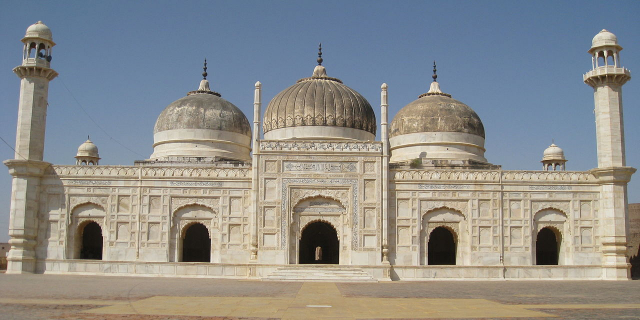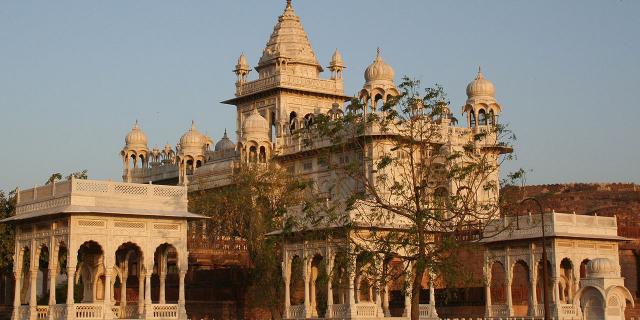जैसलमेर दुर्ग
( Jaisalmer Fort )
Jaisalmer Fort is situated in the city of Jaisalmer, in the Indian state of Rajasthan. It is one of the very few "living forts" in the world (such as Carcassonne, France), as nearly one fourth of the old city's population still resides within the fort. For the better part of its 860-year history, the fort was the city of Jaisalmer. The first settlements outside the fort walls, to accommodate the growing population of Jaisalmer, are said to have come up in the 17th century.
Jaisalmer Fort is the second oldest fort in Rajasthan, built in 1156 AD by the Rawal (ruler) Jaisal from whom it derives its name, and stood at the crossroads of important trade routes (including the ancient Silk road).
The fort's massive yellow sandstone walls are a tawny lion colour during the day, fading to honey-gold as the sun sets, thereby camouflaging the fort in the yellow desert. For this reason it is also known as the Swarn Durg, Sonar Quila or ...Read more
Jaisalmer Fort is situated in the city of Jaisalmer, in the Indian state of Rajasthan. It is one of the very few "living forts" in the world (such as Carcassonne, France), as nearly one fourth of the old city's population still resides within the fort. For the better part of its 860-year history, the fort was the city of Jaisalmer. The first settlements outside the fort walls, to accommodate the growing population of Jaisalmer, are said to have come up in the 17th century.
Jaisalmer Fort is the second oldest fort in Rajasthan, built in 1156 AD by the Rawal (ruler) Jaisal from whom it derives its name, and stood at the crossroads of important trade routes (including the ancient Silk road).
The fort's massive yellow sandstone walls are a tawny lion colour during the day, fading to honey-gold as the sun sets, thereby camouflaging the fort in the yellow desert. For this reason it is also known as the Swarn Durg, Sonar Quila or Golden Fort. The name Sonar Quila (Bengali for Golden Fortress) was popularized by tourists after famous Bengali film of the same name, that was shot in this fort by eminent filmmaker Satyajit Ray. The fort stands amidst the sandy expanse of the great Thar Desert on Trikuta Hill, hence also known as Trikutgarh. It is today located along the southern edge of the city that bears its name; its dominant hilltop location making the sprawling towers of its fortifications visible for many miles around.
In 2013, at the 37th session of the World Heritage Committee held in Phnom Penh, Cambodia, Jaisalmer Fort, along with five other forts of Rajasthan, was declared a UNESCO World Heritage Site under the group Hill Forts of Rajasthan.
 A view of the fortress above the city, in the evening
A view of the fortress above the city, in the eveningLegend has it that the fort was built by Rawal Jaisal, a Bhati Rajput, in 1156 CE.[1] The story says that it superseded an earlier construction at Lodhruva, with which Jaisal was unsatisfied and thus, a new capital was established when Jaisal founded the city of Jaisalmer.
Around 1299 CE, Rawal Jait Singh I faced a long siege by Alauddin Khalji of Delhi Sultanate, who is said to have been provoked by a Bhati raid on his treasure caravan. By the end of the siege, facing certain defeat, the Bhati Rajput women committed 'Jauhar', and the male warriors under the command of Mularaja met their fatal end in battle with the Sultan's forces. For a few years after the successful siege, the fort remained under the sway of Delhi Sultanate, before being eventually reoccupied by some surviving Bhatis.[2]
During Rawal Lunakaran's reign, around 1530–1551 CE, the fort was attacked by an Afghan chief Amir Ali. When it seemed to the Rawal that he was fighting a losing battle, he slaughtered his womenfolk as there was insufficient time to arrange a jauhar. Tragically, reinforcements arrived immediately after the deed was done and the army of Jaisalmer became victorious in its defence of the fort.
In 1541 CE, Rawal Lunakaran also fought Mughal emperor Humayun when the latter attacked the fort on his way to Ajmer.[3] He also offered his daughter in marriage to Akbar. Mughals controlled the fort until 1762.[4]
The fort remained under the control of Mughals until 1762, when Maharawal Mulraj took control of the fort.
The treaty between the East India Company and Mulraj on 12 December 1818 allowed the Mulraj to retain control of the fort and provided for protection from invasion. After the death of Mulraj in 1820, his grandson Gaj Singh inherited control of the fort.[4]
With the advent of British rule, the emergence of maritime trade and the growth of the port of Bombay led to the gradual economic decline of Jaisalmer. After independence and the Partition of India, the ancient trade route was totally closed, thus permanently removing the city from its former role of importance in international commerce. Nonetheless, the continued strategic importance of Jaisalmer was demonstrated during the 1965 and 1971 wars between India and Pakistan.[citation needed]
Even though the town of Jaisalmer no longer serves as an important trading city, or as a major military post, the town is still able to earn revenues as a major tourist destination. Initially, the entire population of Jaisalmer lived within the fort, and today the old fort still retains a resident population of about 4,000 people who are largely descended from the Brahmin and Rajput communities. These two communities once served as the workforce for the fort's one time Bhati rulers, which service then entitled the workers to reside on the hilltop and within the walls of the fort.[5] With the slow increase in the area's population, many of the town's residents gradually relocated to the foot of the Trikuta Hill. From there the town's population has since largely spread out well beyond the old walls of the fort, and into the adjacent valley below.
































Add new comment